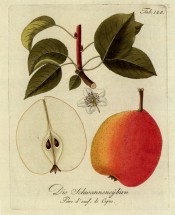Pyrus communis ‘Moorfowl Egg’
‘Fruit rather small, of a globular-ovate figure, abruptly tapering from the middle, both to the crown and the stalk, about two inches and three quarters deep, and the same in diameter. Eye small, open, with a short, slender, strigose calyx, placed in a rather narrow and shallow basin. Stalk one inch and a half long, slightly inserted by the side of a small elongated lip. Skin pale yellow, mixed with green, and tinged on the sunny side with a lively orange-brown, interspersed with numerous minute russetty spots. Flesh yellowish white, a little gritty, but tender and mellow. Juice sugary, with a slight perfume. Ripe the end of September, and will keep two or three weeks.’ [George Lindley – Orchard Guide p.361/1831].
Horticultural & Botanical History
‘This is a Scotch variety, and partakes something of the Swan's Egg. It is a desirable and hardy fruit.’ [George Lindley – Orchard Guide p.361/1831]. I have no information on its date of introduction. It is probably the pear figured in Pomona Austriaca as ‘Die Schwanneneybirn’ or ‘Poir d’Oeuf de Cigne’ [Pomona Austriaca t.128/1792], the illustration used here.
History at Camden Park
Listed in the 1850 and 1857 catalogues [Pear no.25/1850]. There is no diary entry for this pear.
Notes
Published May 18, 2010 - 05:18 PM | Last updated Jul 22, 2011 - 02:49 PM
| Family | Rosaceae |
|---|---|
| Category | |
| Region of origin | Garden origin, Scotland |
| Synonyms | |
| Common Name | Dessert Pear, autumn |
| Name in the Camden Park Record |
Moorfowl Egg |
| Confidence level | high |


